Have you ever walked into a room that instantly made you feel calm and centered? That’s the magic of Japandi design—a perfect blend of Japanese minimalism and Scandinavian coziness that creates spaces radiating tranquility and understated elegance. This harmonious style has skyrocketed in popularity because it offers a serene retreat from the chaos of everyday life, all while maintaining a chic, modern aesthetic.
It’s the ideal approach for anyone looking to craft a dining area that feels both stylish and soothing. In this article, you’ll find a treasure trove of inspiration and practical ideas to transform your dining room into a Japandi haven.
From choosing the right color palettes and furniture to incorporating natural textures and clever storage solutions, each tip is designed to help you achieve that coveted calm elegance. Whether you’re starting from scratch or simply looking to refine your current space, these ideas will guide you toward a beautifully balanced and inviting dining environment.
Creating a calm and balanced dining space starts with selecting the right color palette, and nothing embodies this better than neutral tones. Soft shades like warm beiges, cool grays, creamy whites, and gentle taupes set a tranquil tone that promotes relaxation and clarity.
These colors act as a soothing backdrop, allowing natural textures and subtle design elements to shine without overwhelming the senses. When thoughtfully combined, they foster an environment of understated elegance and peacefulness, perfect for mindful dining moments.
Imagine walking into a dining room painted in a muted dove gray, accented with a light oak table and matching cabinetry. The walls are smooth and matte, reflecting soft natural light that filters through shoji screens, enhancing the space’s airy feel.
Textural contrasts like a plush, off-white wool rug and a linen table runner add tactile interest, making the space inviting without visual clutter. The overall atmosphere is calm, with each element harmonizing effortlessly, evoking a sense of serenity and simplicity.
To achieve this look, start with a neutral wall color—think a warm, sandy beige or a cool, stone gray. Use furniture in similar tones with subtle variations for depth, such as a light wood dining table paired with upholstered chairs in soft, muted fabrics.
Incorporate textiles like linen or cotton for cushions or table runners, and opt for natural materials like ceramic or matte-finish metal for accessories. Keep decor minimal and cohesive, focusing on quality over quantity to maintain the peaceful aesthetic.
1. Incorporate Minimalist Furniture with Clean Lines
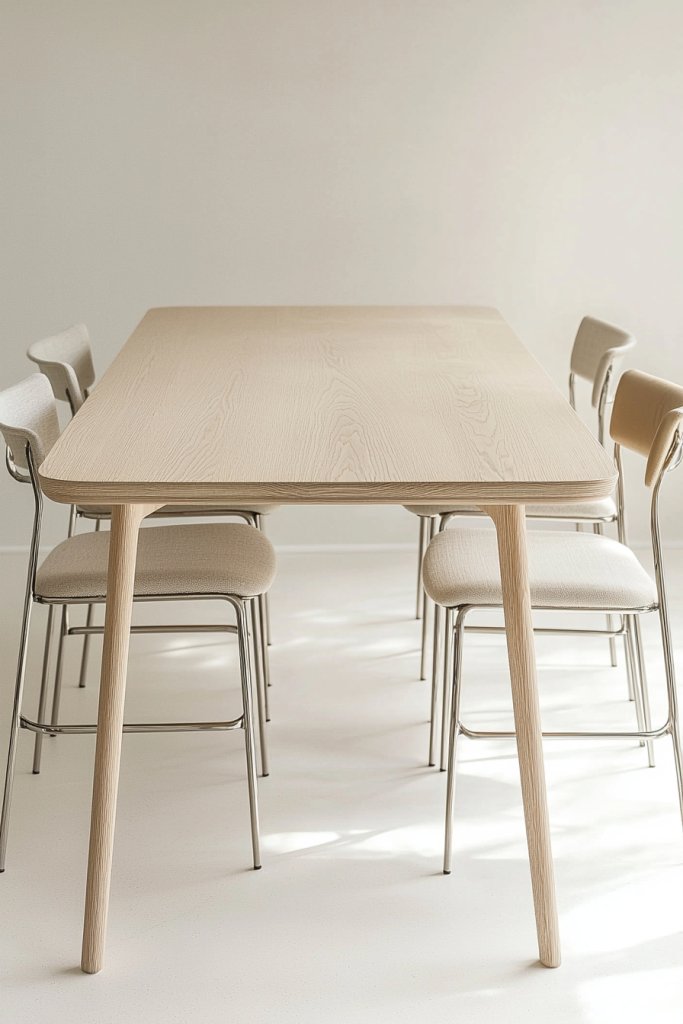
In Japandi design, furniture with sleek, minimalist profiles plays a crucial role in fostering an uncluttered, calming environment. Pieces with simple geometric shapes, smooth surfaces, and understated details contribute to a sense of order and sophistication.
Avoid ornate carvings or overly decorative elements; instead, focus on functional, well-crafted furniture that blends form and function seamlessly. This approach ensures the space remains open and inviting, encouraging effortless flow and relaxation.
Picture a low-profile dining table crafted from light oak or ash, with straight, slim legs that give it an airy feel. Chairs are streamlined, perhaps with thin metal legs and a minimalist fabric or leather seat, emphasizing comfort without visual heaviness.
The furniture’s clean lines and neutral finishes create a balanced visual rhythm, making the room feel spacious and harmonious. The simplicity of these pieces invites calmness and allows other design elements to stand out subtly, contributing to the overall serene vibe.
Getting started is straightforward: choose furniture made from natural wood or matte-finished metals with simple silhouettes. Look for designs that emphasize function—like a sturdy yet lightweight dining table or stackable chairs for flexibility.
Keep surfaces uncluttered, and opt for pieces with smooth, unadorned details to maintain a refined minimalist aesthetic. Remember, less is more: select quality over quantity for a polished, calm space that’s easy to maintain.
2. Use Natural Wood Finishes to Add Warmth and Texture
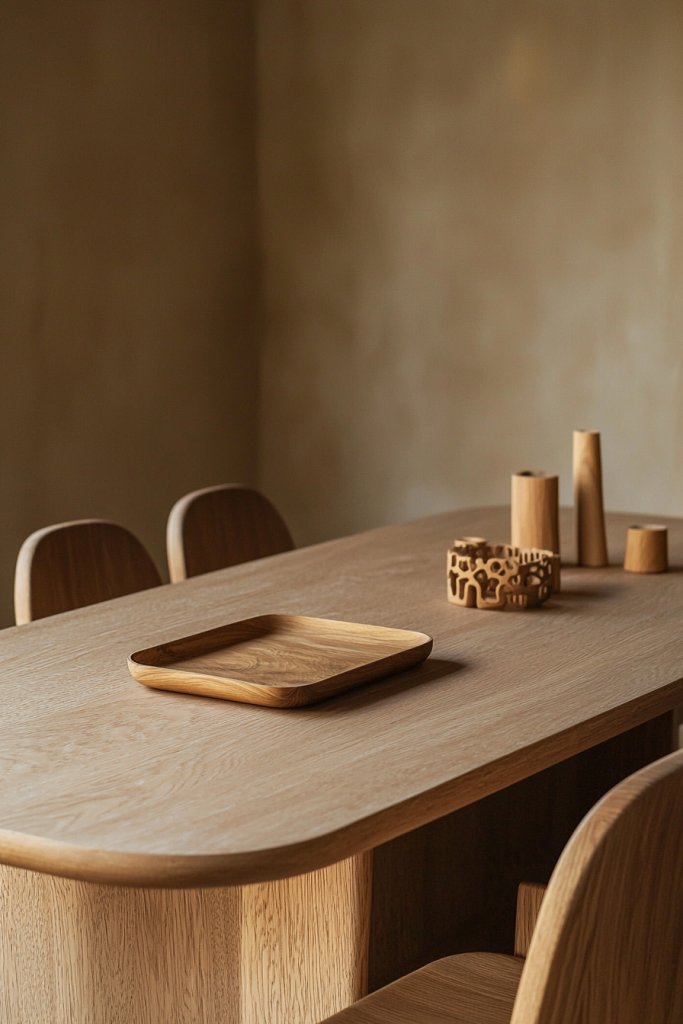
Natural wood is the heart of Japandi style, bringing warmth, texture, and a sense of grounding to the dining room. Whether you opt for light oak, ash, or bamboo, the organic grains and matte finishes evoke a connection to nature that instantly calms the mind.
These wooden elements can be introduced through tables, chairs, cabinetry, or accent pieces, creating a layered, inviting atmosphere that balances modern minimalism with rustic charm. Visualize a dining area where a smooth, matte-finished oak table anchors the space, complemented by matching wooden chairs with rounded edges.
The subtle grain patterns in the wood add visual depth, while the warm tones contrast beautifully with cool-colored walls, creating a cozy yet refined environment. Scattered throughout the space are small wooden accessories—like a carved tray or a set of minimalist candle holders—that enhance the tactile richness and natural vibe.
The overall effect is a space that feels both peaceful and tactile, inviting you to linger. To incorporate natural wood finishes, start with a statement piece like a dining table or sideboard in light or medium tones.
Finish or treat the wood with natural oils or matte varnishes to preserve its organic look. Mix different wood textures to add subtle contrast, and keep other materials neutral and understated to highlight the wood’s natural beauty. This approach fosters a warm, inviting atmosphere that embodies Japandi’s essence of calm and craftsmanship.
3. Opt for Simple, Functional Lighting Fixtures with Soft Glows
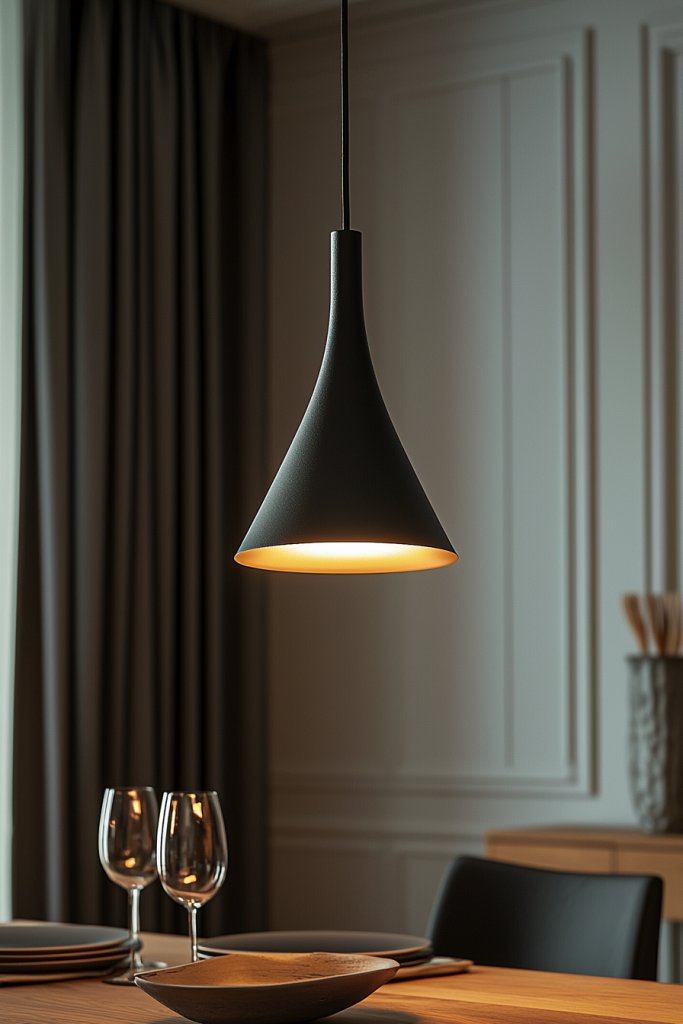
Lighting plays a vital role in creating the tranquil atmosphere of a Japandi dining room. Instead of elaborate chandeliers or harsh overhead lights, opt for simple, functional fixtures that emit a soft, warm glow.
Pendant lights with matte finishes, woven rattan or bamboo shades, or minimalist wall sconces help to diffuse light gently, enhancing the space’s calm and cozy feel. The goal is to illuminate without overwhelming, fostering a soothing environment perfect for relaxed meals.
Imagine a pendant light with a sleek, matte-black or neutral-colored shade hanging low over the dining table, casting a warm, diffuse light that invites intimacy. Alternatively, a pair of woven rattan sconces on either side of a subtle wall feature can provide ambient lighting, adding texture and visual interest.
The light’s soft glow creates gentle shadows and highlights the natural textures within the room, making the space feel welcoming and serene. The key is to select fixtures that blend seamlessly into the decor while providing functional, mood-enhancing illumination.
To implement this, choose lighting fixtures with understated designs—think simple metal or ceramic pendants, or woven shades that soften the light. Use warm LED bulbs to achieve a cozy, inviting atmosphere.
Install dimmer switches to adjust brightness based on mood or time of day. Keep the overall lighting minimal but layered, combining overhead, task, and ambient sources to create a balanced, tranquil dining environment.
4. Add Sculptural Ceramics as Statement Centerpieces
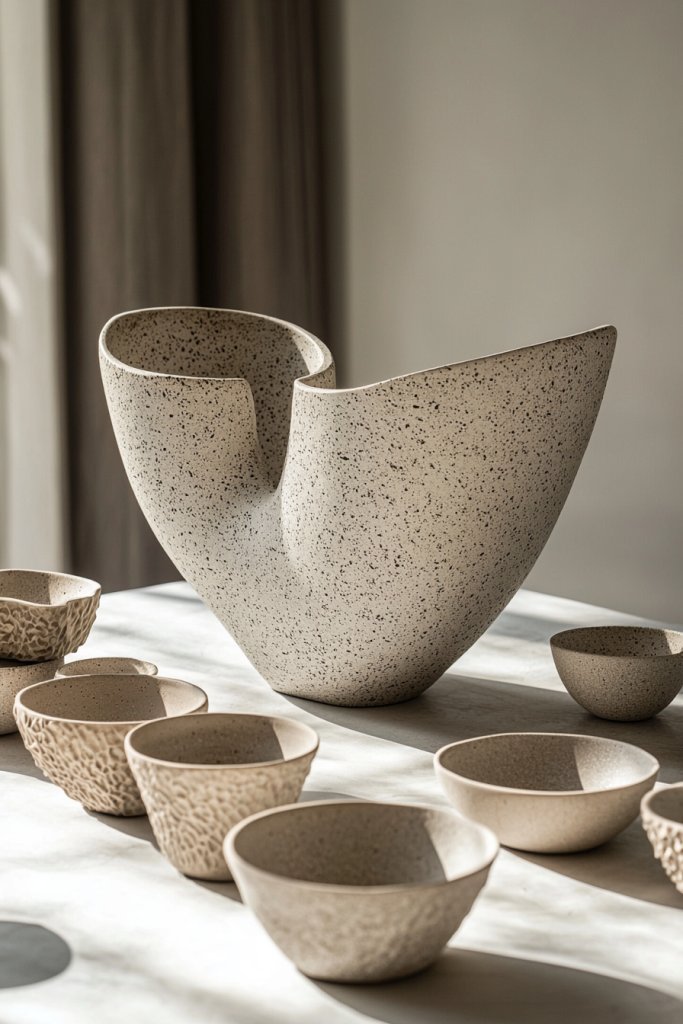
Sculptural ceramics serve as eye-catching focal points that elevate the simplicity of a Japandi dining room. These pieces—think of organic-shaped vases, minimalist bowls, or abstract sculptures—bring an artistic touch that blends functionality with visual intrigue.
Their muted, earthy tones like matte terracotta, stone gray, or soft clay give a natural, calming presence, complementing the room’s understated elegance and fostering a sense of serenity. Imagine a large, matte ceramic vessel with an asymmetrical form placed at the center of the table, or a set of smaller, textured bowls arranged in an artful cluster.
The tactile surface of these ceramics invites viewers to appreciate their craftsmanship, while their subtle irregularities echo the organic forms found in nature. The visual harmony lies in their simplicity—clean lines combined with imperfect, handcrafted details—creating a sophisticated yet approachable aesthetic.
To incorporate sculptural ceramics, visit local pottery studios or browse online artisans for unique pieces. Choose one large statement piece or a curated collection of smaller vessels that can hold flowers, fruits, or simply stand alone.
For an easy start, purchase a versatile bowl or vase in neutral tones and place it at the table’s center. These ceramics are durable and timeless, making them a practical addition that enhances your space’s calm elegance with minimal effort.
5. Choose Hidden or Discreet Storage Solutions to Maintain Clarity
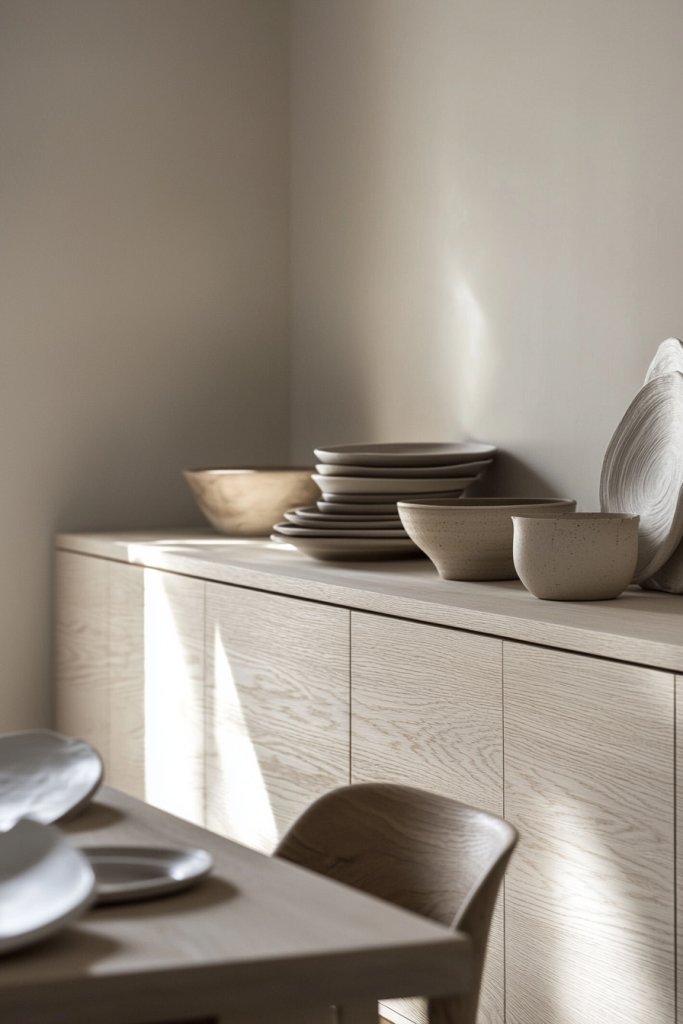
In a Japandi dining room, clutter is kept at bay through smart, hidden storage solutions that preserve the space’s calm and uncluttered vibe. Think built-in cabinetry, under-table drawers, or sleek sideboards with push-to-open doors that conceal everyday items like placemats, tableware, or cleaning supplies.
Discreet storage keeps the aesthetic minimalist and prevents visual noise, allowing the room’s natural materials and textures to shine. Visually, this approach means surfaces remain clean and free of clutter, with storage integrated seamlessly into the room’s architecture.
A low-profile sideboard in light wood, with handle-less doors, can tuck away table linens and serveware, while the tabletop remains a pristine surface for ceramics or sculptures. Invisible storage options emphasize simplicity and order, creating a peaceful environment that encourages relaxation and social connection.
To implement, start with multifunctional furniture like a sideboard or credenza that blends with your room’s wood tones. Opt for pieces with concealed compartments or push-to-open mechanisms—these are widely available at furniture stores or customizable DIY options.
Keep everyday essentials out of sight but easily accessible, so the space remains serene and functional. This approach not only enhances visual clarity but also simplifies daily routines, making your dining area a true sanctuary of calm.
6. Integrate Subtle Metallic Accents for a Touch of Sophistication
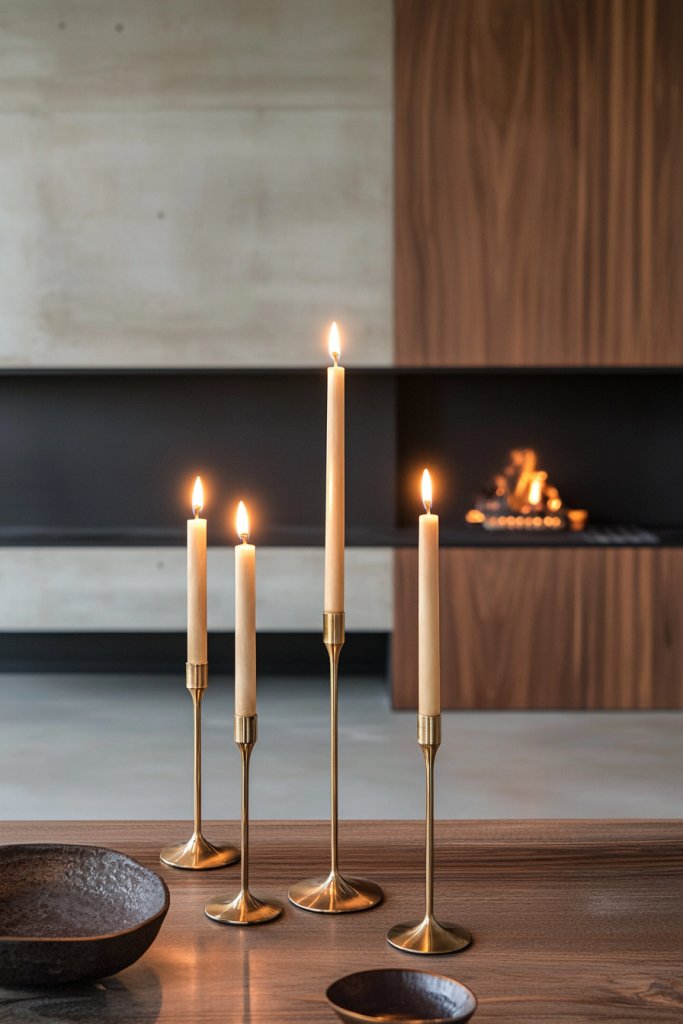
Adding subtle metallic accents introduces a refined, sophisticated edge to the quiet elegance of a Japandi dining room. Think thin brass or matte black metal details—such as minimalist candlestick holders, sleek tray edges, or decorative bowls—that catch light without overpowering the space’s natural aesthetic.
These small touches elevate the room by providing visual contrast and a hint of luxury, enriching the overall harmony. Imagine a set of slender brass candlesticks on the table, their warm hue reflecting soft candlelight, or a matte black metal frame around a simple centerpiece.
These accents act as subtle focal points that draw the eye and add depth to the minimalist palette, balancing natural textures with a hint of modern refinement. The key is restraint—using metallics sparingly so they enhance without disrupting the room’s calm, understated feel.
To incorporate these accents, look for budget-friendly options like brushed brass or matte black accessories at home decor stores or online boutiques. Use them to highlight key features like tableware, lighting fixtures, or decorative objects.
Keep the metallic elements simple and cohesive, ensuring they complement the room’s overall palette. This delicate touch of sheen and metal creates a layered, sophisticated atmosphere that elevates your dining experience while maintaining the room’s tranquil essence.
7. Use Shoji-Style Screens or Partitions to Define the Space
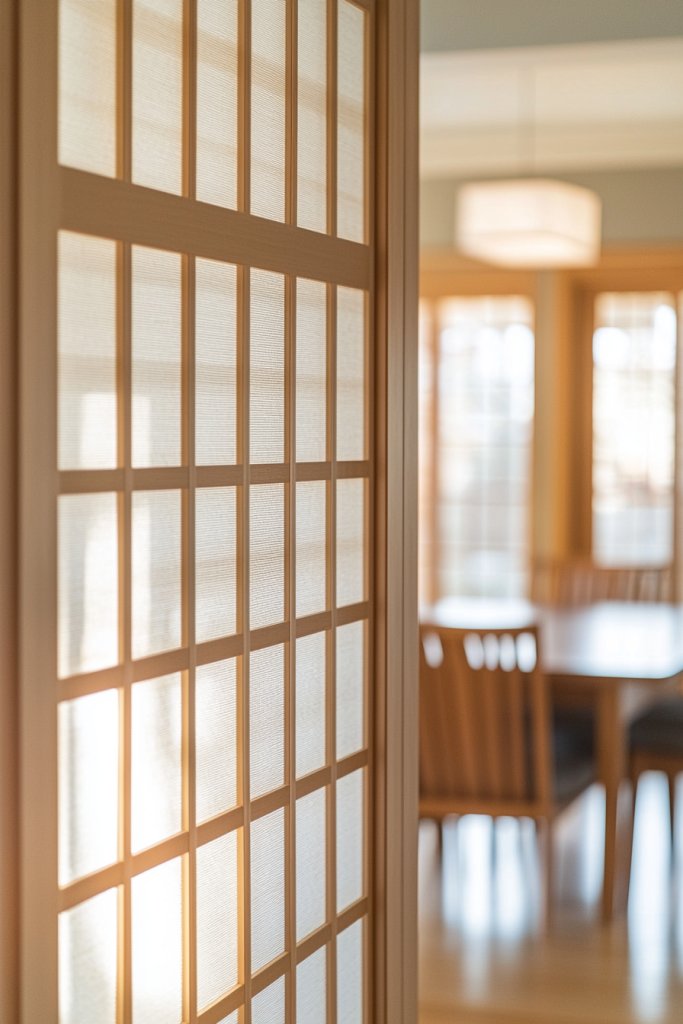
Shoji-style screens or partitions are quintessential elements of Japandi design, offering both visual separation and a soft, diffused light quality that enhances the room’s serenity. Typically made of lightweight wood frames and translucent paper or fabric panels, these screens create a flexible boundary that defines the dining area without making the space feel closed off.
Their minimalist design complements the simple, natural aesthetic of Japandi interiors. Visualize a delicate grid of light wood framing a semi-transparent paper panel, softly filtering sunlight into the room.
When positioned strategically, a shoji screen can divide the dining space from adjacent areas or serve as a decorative backdrop. Its subtle translucency allows light to pass through gently, creating a calm, airy atmosphere.
The natural wood finish and clean lines contribute to the overall sense of harmony and balance. To incorporate shoji-style screens, choose a lightweight, foldable version that’s easy to move and adjust.
You can find affordable kits online or at home improvement stores, or opt for custom-made panels for a perfect fit. Position the screen where you want to create a sense of separation or privacy, and ensure it aligns with your room’s neutral palette and natural materials. This simple addition enhances spatial flow and tranquility, embodying the essence of Japandi elegance.
8. Incorporate Modular or Multi-Functional Furniture for Practicality
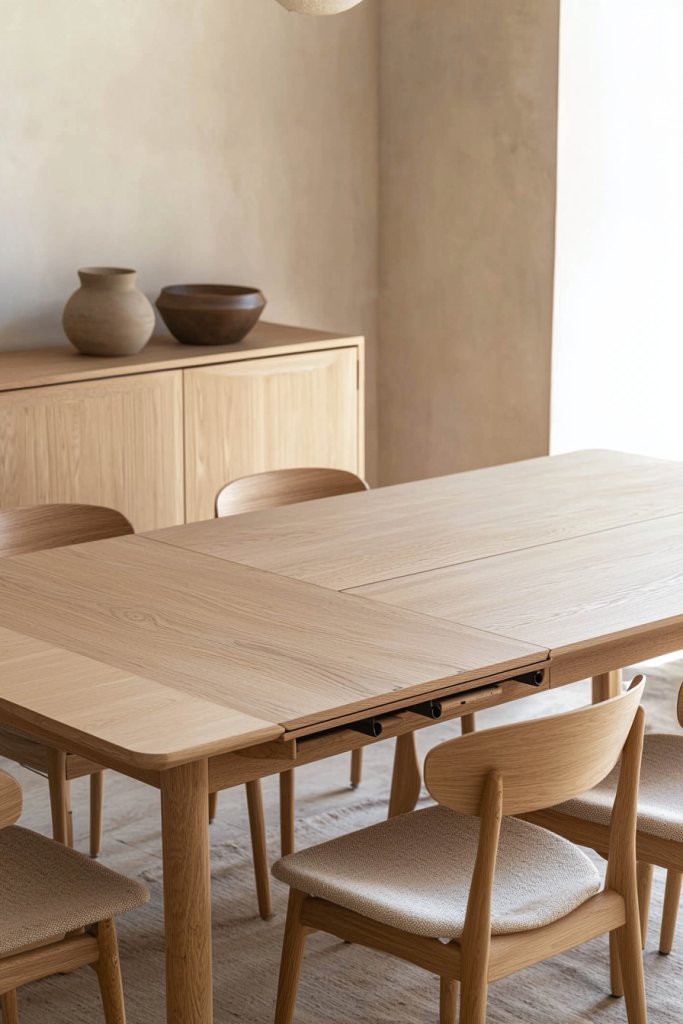
In a Japandi dining room, space efficiency and versatility are key to maintaining that serene, uncluttered vibe. Modular or multi-functional furniture allows you to adapt the space seamlessly, whether for everyday meals or larger gatherings, all while preserving the minimalist aesthetic.
This approach is especially valuable for smaller homes or open-plan layouts, where every piece of furniture needs to serve more than one purpose. Imagine a sleek, low-profile dining table with extendable leaves made of light, natural wood, paired with stackable chairs that can be tucked away when not in use.
Alternatively, consider a sideboard that doubles as a storage unit and a display surface for ceramics or sculptures. These pieces often feature clean lines, subtle hardware, and simple designs that blend effortlessly with the neutral colors and textured textiles typical of Japandi style.
Their flexible nature helps keep clutter at bay and enhances the overall harmony of the space. To implement this idea, start by choosing a core piece like a extendable dining table made from light oak or ash—materials that add warmth without overpowering the aesthetic.
Look for multi-purpose furniture such as a storage bench or a fold-out side table, which can be sourced from affordable brands or DIYed with basic woodworking skills. Keep your space organized with hidden compartments or minimalist storage solutions to maintain that calm, balanced atmosphere. This way, your dining area remains both functional and beautifully simple.
9. Select Elegant, Uncluttered Wall Decor with Geometric or Abstract Shapes
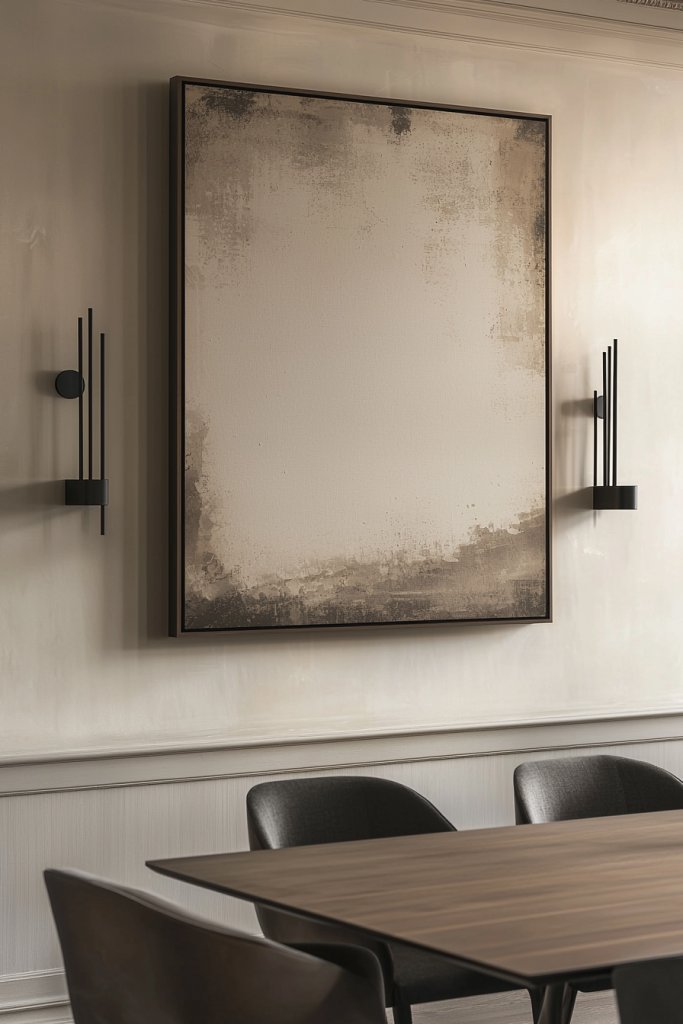
In a Japandi-inspired dining room, wall decor plays a crucial role in adding visual interest without disrupting the tranquil, minimalist vibe. Opting for elegant, uncluttered pieces with geometric or abstract shapes helps create a sophisticated backdrop that complements the clean lines of your furniture.
The key is to strike a balance—each piece should enhance the space without overwhelming it. Picture a large, framed abstract print in muted tones of beige, gray, or black, hung slightly above eye level to anchor the room.
Alternatively, think of a series of small, minimalist wall sculptures in matte black or brushed metal, arranged in a linear or asymmetrical pattern. These elements add subtle texture and dimension, creating focal points that draw the eye without cluttering the walls.
Keep the color palette neutral and the framing simple—think thin black or wooden frames—to maintain that calm, refined aesthetic. To achieve this look, choose a few statement pieces—perhaps a geometric wall mirror or a set of monochrome prints—and hang them with careful spacing.
Use wall-mounting hardware that’s discreet to avoid visual clutter. Remember, less is more; select artworks or decor that resonate with the overall palette and style, and keep surfaces clear to preserve the serene, uncluttered environment. This approach ensures your walls add elegance without overpowering the room’s calming spirit.
10. Use Soft Area Rugs to Anchor the Dining Space with Texture
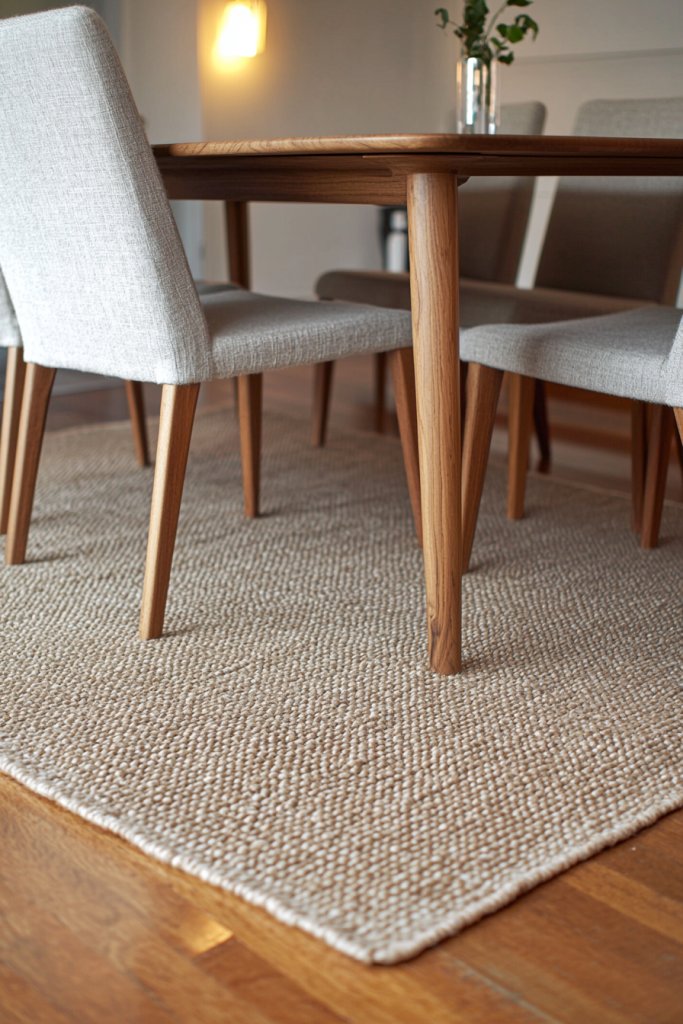
A soft area rug acts as the foundation of a calm, cohesive Japandi dining room, adding warmth and tactile richness to the space. It visually defines the dining area while balancing the room’s minimalist aesthetic with inviting textures.
The right rug can transform an open space into a cozy, harmonious retreat. Imagine a plush, wool or jute rug in a neutral hue—think oatmeal, light gray, or beige—laid beneath the dining table and chairs.
Its soft fibers absorb sound, creating a quiet, peaceful environment, while its natural fibers add subtle texture that complements wood finishes and textiles. The rug’s size should be generous enough to extend beyond the table’s edges, ensuring chairs stay on the surface even when pulled out.
The tactile quality enhances the sensory experience, making meals feel more intimate and comforting. To implement this, select a high-quality, easy-care rug in natural materials like wool, jute, or sisal.
Measure your space carefully to choose a rug that’s large enough to anchor the entire dining setup. Place it directly on a smooth, hard floor—such as wood or concrete—to maximize comfort.
For a layered look, you can add a smaller, textured rug or mat underneath to introduce additional detail. Keep the surrounding decor minimal but cohesive, allowing the rug’s softness and texture to subtly elevate the overall atmosphere.
11. Incorporate Natural Materials Like Rattan or Bamboo for Subtle Contrast
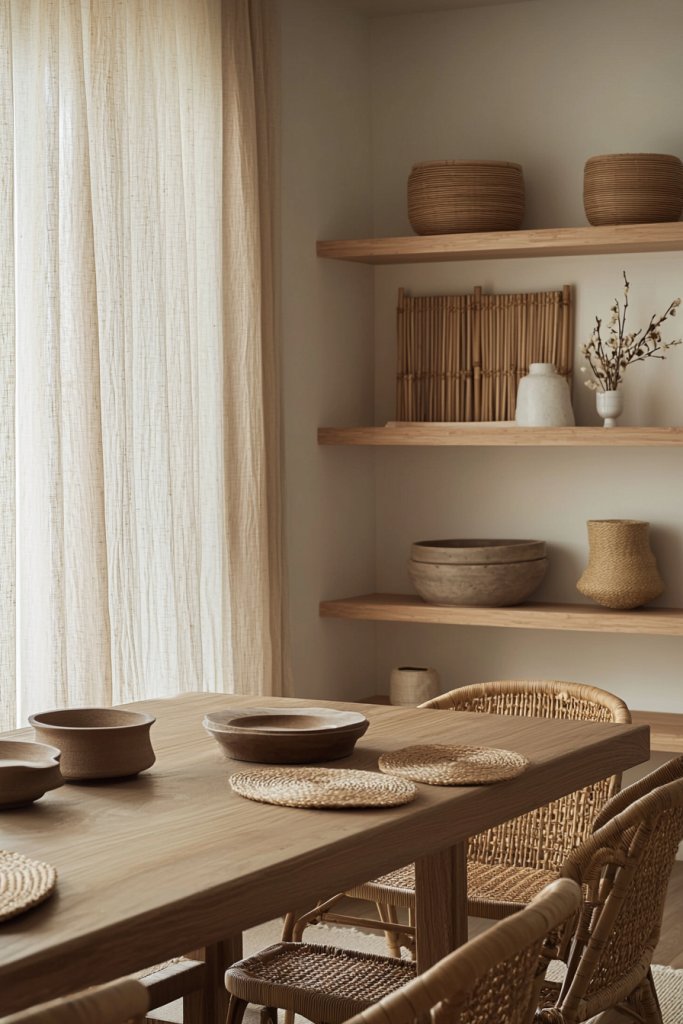
Using natural materials such as rattan or bamboo introduces a gentle contrast within the Japandi aesthetic, emphasizing eco-friendly design and tactile interest. These materials add a subtle warmth and organic texture that complements the sleek wood, stone, and textiles typical of the style, enriching the overall sensory experience without cluttering the space.
Picture a rattan pendant light hanging above the dining table, or bamboo placemats and coasters arranged neatly on the surface. Rattan chairs with simple, curved frames or woven backs can also serve as eye-catching yet unobtrusive seating options.
These elements bring visual depth and a touch of nature indoors, softening the clean lines of furniture and creating a balanced, harmonious environment. Their muted, earthy tones blend seamlessly with neutral palettes, making the space feel inviting and grounded.
To incorporate these materials, start with small accents like woven baskets, placemats, or light fixtures made from rattan or bamboo—readily available at home decor stores or online. For larger pieces, consider a rattan or bamboo chair, ensuring it matches the room’s scale and style.
Keep the overall look light and airy by balancing these natural textures with smooth wood surfaces and textiles. This subtle contrast injects warmth and personality into your dining space while maintaining its serene, minimalist charm.
12. Keep the Overall Space Uncluttered to Enhance Calm and Balance
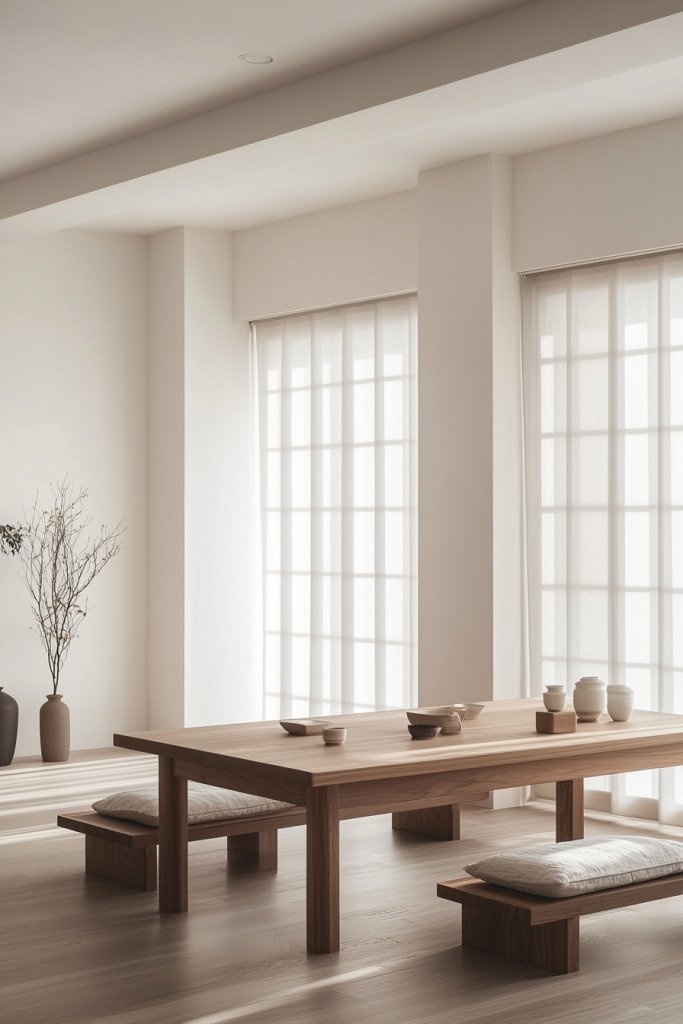
A key principle of Japandi design is maintaining a sense of order and tranquility through minimalism, and this extends to the entire dining space. Keeping the room uncluttered allows your mind to breathe and helps emphasize the natural beauty of each element.
Start by removing unnecessary furniture, decorations, and accessories that don’t serve a functional or aesthetic purpose. Opt for sleek storage solutions like built-in cabinets, hidden drawers, or minimalist sideboards to keep surfaces clear.
When decorating, choose a few carefully curated objects—such as a sculptural ceramic piece, a textured throw, or a simple vase—placed intentionally to create visual interest without overwhelming the space. Clutter-free surfaces and open sightlines foster a peaceful environment, perfect for mindful dining experiences.
Visually, an uncluttered Japandi dining room feels airy and harmonious. The space features neutral walls—perhaps in soft greys or warm beiges—that act as a calming backdrop.
The furniture is streamlined and low-profile, with natural wood finishes that add warmth. The floor might be covered with a simple, textured rug in muted tones, anchoring the space without crowding it.
Decorative objects are sparingly placed, allowing each piece to stand out. Lighting is soft and unobtrusive, such as recessed fixtures or a single pendant with a warm glow, enhancing the serene mood.
The overall space feels uncluttered yet thoughtfully styled, creating an environment that promotes relaxation and balance. To achieve this, start by decluttering your space—store away non-essential items in hidden compartments or elsewhere.
Use minimal decor, focusing on quality over quantity, and regularly assess your layout to ensure each piece contributes to the tranquility. Incorporate smart storage solutions like floating shelves or sleek cabinets to hide everyday items.
Maintain a sense of visual balance by keeping surfaces clear and organized, and choose furniture with simple lines that don’t overpower the space. Regularly tidying and editing your decor will help sustain the calm, balanced atmosphere that’s central to Japandi style, making your dining room a peaceful haven for everyday life and special occasions alike.
Conclusion
With a thoughtful blend of neutral palettes, minimalist furniture, natural textures, and subtle accents, these Japandi dining room ideas offer a perfect balance of calm and elegance. By incorporating simple yet functional elements like hidden storage, sculptural ceramics, and soft lighting, you can create a serene space that feels both inviting and beautifully uncluttered.
Don’t hesitate to experiment with these concepts to craft a dining area that reflects your personal style and promotes peaceful gatherings. Embrace the Japandi aesthetic and transform your dining space into a sanctuary of calm sophistication.
Leave a Reply